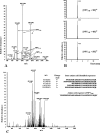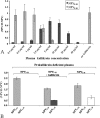Kinetic study of neuropeptide Y (NPY) proteolysis in blood and identification of NPY3-35: a new peptide generated by plasma kallikrein
- PMID: 19620246
- PMCID: PMC2757175
- DOI: 10.1074/jbc.M109.035253
Kinetic study of neuropeptide Y (NPY) proteolysis in blood and identification of NPY3-35: a new peptide generated by plasma kallikrein
Abstract
There is little information on how neuropeptide Y (NPY) proteolysis by peptidases occurs in serum, in part because reliable techniques are lacking to distinguish different NPY immunoreactive forms and also because the factors affecting the expression of these enzymes have been poorly studied. In the present study, LC-MS/MS was used to identify and quantify NPY fragments resulting from peptidolytic cleavage of NPY(1-36) upon incubation with human serum. Kinetic studies indicated that NPY(1-36) is rapidly cleaved in serum into 3 main fragments with the following order of efficacy: NPY(3-36) >> NPY(3-35) > NPY(2-36). Trace amounts of additional NPY forms were identified by accurate mass spectrometry. Specific inhibitors of dipeptidyl peptidase IV, kallikrein, and aminopeptidase P prevented the production of NPY(3-36), NPY(3-35), and NPY(2-36), respectively. Plasma kallikrein at physiological concentrations converted NPY(3-36) into NPY(3-35). Receptor binding assays revealed that NPY(3-35) is unable to bind to NPY Y1, Y2, and Y5 receptors; thus NPY(3-35) may represent the major metabolic clearance product of the Y2/Y5 agonist, NPY(3-36).
Figures








Similar articles
-
Proteolytic degradation of neuropeptide Y (NPY) from head to toe: Identification of novel NPY-cleaving peptidases and potential drug interactions in CNS and Periphery.J Neurochem. 2015 Dec;135(5):1019-37. doi: 10.1111/jnc.13378. Epub 2015 Nov 16. J Neurochem. 2015. PMID: 26442809
-
Dipeptidyl peptidase IV (DPP-IV) inhibition prevents fibrosis in adipose tissue of obese mice.Biochim Biophys Acta Gen Subj. 2018 Mar;1862(3):403-413. doi: 10.1016/j.bbagen.2017.11.012. Epub 2017 Dec 22. Biochim Biophys Acta Gen Subj. 2018. PMID: 29154902
-
Dipeptidyl-peptidase-IV by cleaving neuropeptide Y induces lipid accumulation and PPAR-γ expression.Peptides. 2012 Sep;37(1):49-54. doi: 10.1016/j.peptides.2012.06.014. Epub 2012 Jul 20. Peptides. 2012. PMID: 22819773
-
Neuropeptide Y receptor subtypes, Y1 and Y2.Ann N Y Acad Sci. 1990;611:7-26. doi: 10.1111/j.1749-6632.1990.tb48918.x. Ann N Y Acad Sci. 1990. PMID: 2174225 Review.
-
Molecular characterization of the ligand-receptor interaction of the neuropeptide Y family.J Pept Sci. 2000 Mar;6(3):97-122. doi: 10.1002/(SICI)1099-1387(200003)6:3<97::AID-PSC236>3.0.CO;2-E. J Pept Sci. 2000. PMID: 10759209 Review.
Cited by
-
Ultrasensitive and Cost-Effective Detection of Neuropeptide-Y by a Disposable Immunosensor: A New Functionalization Route for Indium-Tin Oxide Surface.Biosensors (Basel). 2022 Oct 26;12(11):925. doi: 10.3390/bios12110925. Biosensors (Basel). 2022. PMID: 36354435 Free PMC article.
-
Neuropeptide Y is produced by adipose tissue macrophages and regulates obesity-induced inflammation.PLoS One. 2013;8(3):e57929. doi: 10.1371/journal.pone.0057929. Epub 2013 Mar 5. PLoS One. 2013. PMID: 23472120 Free PMC article.
-
Proteomic identification of novel plasma kallikrein substrates in the astrocyte secretome.Transl Stroke Res. 2010 Dec;1(4):276-86. doi: 10.1007/s12975-010-0039-z. Epub 2010 Aug 28. Transl Stroke Res. 2010. PMID: 24323554
-
Structural basis of neuropeptide Y signaling through Y1 and Y2 receptors.MedComm (2020). 2024 Jun 15;5(7):e565. doi: 10.1002/mco2.565. eCollection 2024 Jul. MedComm (2020). 2024. PMID: 38882210 Free PMC article.
-
Role of plasma kallikrein in diabetes and metabolism.Thromb Haemost. 2013 Sep;110(3):434-41. doi: 10.1160/TH13-02-0179. Epub 2013 May 16. Thromb Haemost. 2013. PMID: 23676986 Free PMC article. Review.
References
-
- Wahlestedt C., Edvinsson L., Ekblad E., Håkanson R. (1985) J. Pharmacol. Exp. Ther. 234, 735–741 - PubMed
-
- Walker P., Grouzmann E., Burnier M., Waeber B. (1991) Trends Pharmacol. Sci. 12, 111–115 - PubMed
-
- Abdel-Samad D., Jacques D., Perreault C., Provost C. (2007) Peptides 28, 281–287 - PubMed
-
- Sahu A., Kalra S. P. (1993) Trends Endocrinol. Metab. 4, 217–224 - PubMed
Publication types
MeSH terms
Substances
LinkOut - more resources
Full Text Sources
Other Literature Sources
Research Materials
Miscellaneous

